emonCMS: Getting started emonPi/Base
Login and account creation
This guide picks up at the point where the emonPi, emonBase or raspberryPi is powered up and connected to the local network. You should have completed the initial ethernet or WiFi connection wizard and now be presented with the emoncms login page.
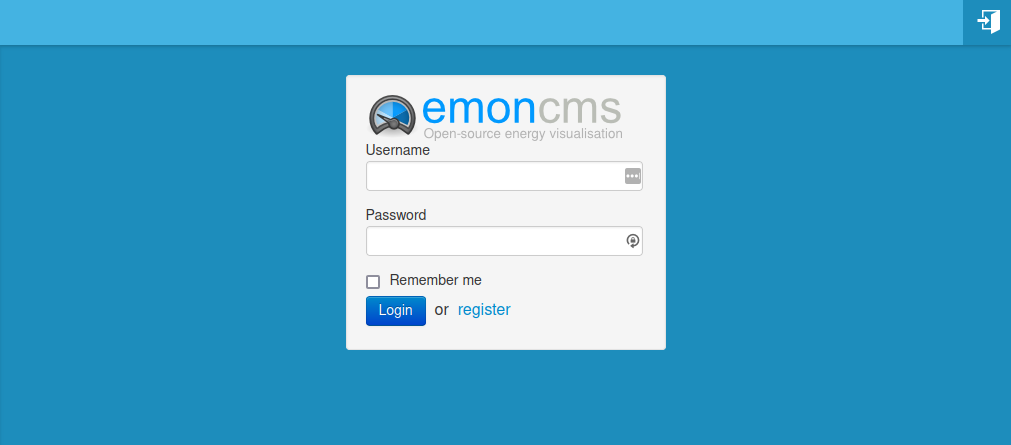
EmonCMS is the main user interface on the emonPi/base, it can be used to store and visualise data locally or just used to configure posting data to a remote server, or both.
1. Login with default username emonsd and password emonsd
These credentials can be changed once logged in.
2. When you first login, emonCMS opens on the Feeds page. Feeds store time-series data. This page will be empty to start with, once created, feeds will appear listed on this page.
While it’s possible to create feeds directly on the feeds page and insert data either via the feed API or CSV import tool, the main way of creating feeds is via the Inputs page.
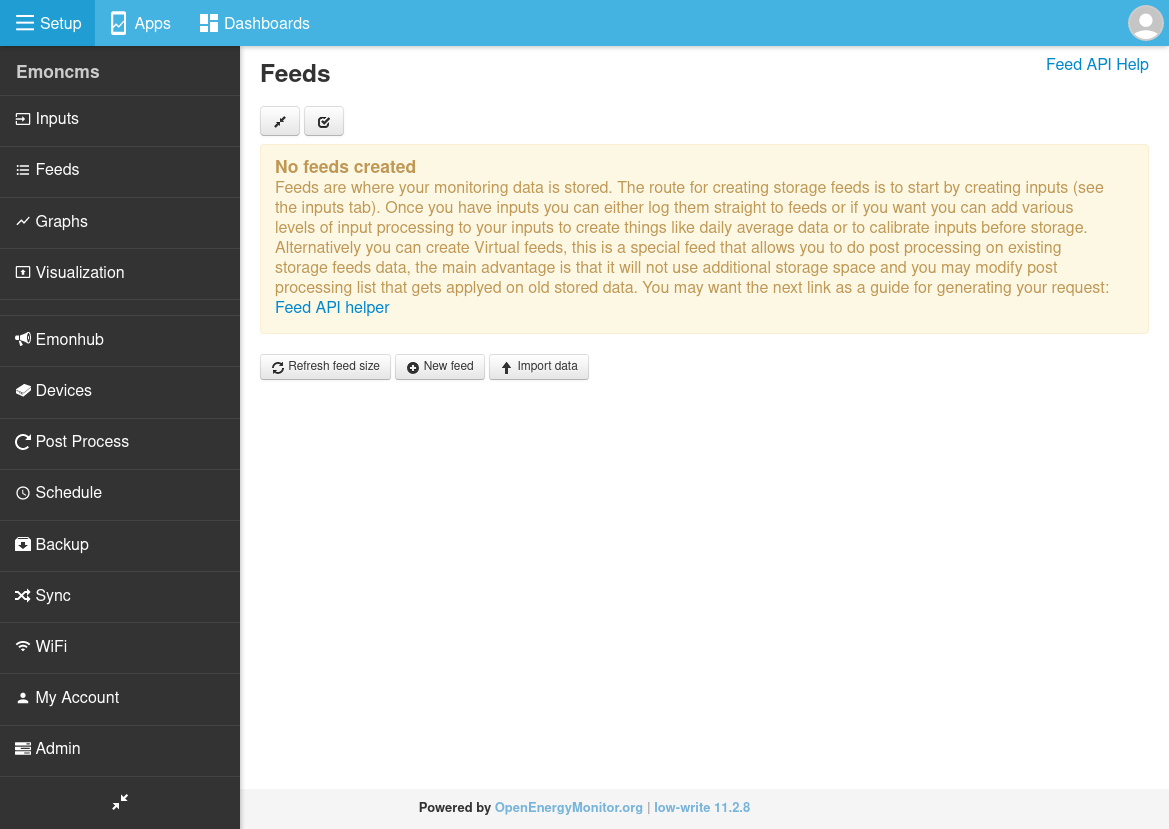
3. Using the setup menu to the left, navigate to the Inputs page. If you have an emonBase and already have a node such as the emonTx4 powered up and transmitting data via RFM69 radio or USB cable, you should see data appear on this page automatically. If you have an emonPi, it’s data will also appear on this page in the same way.
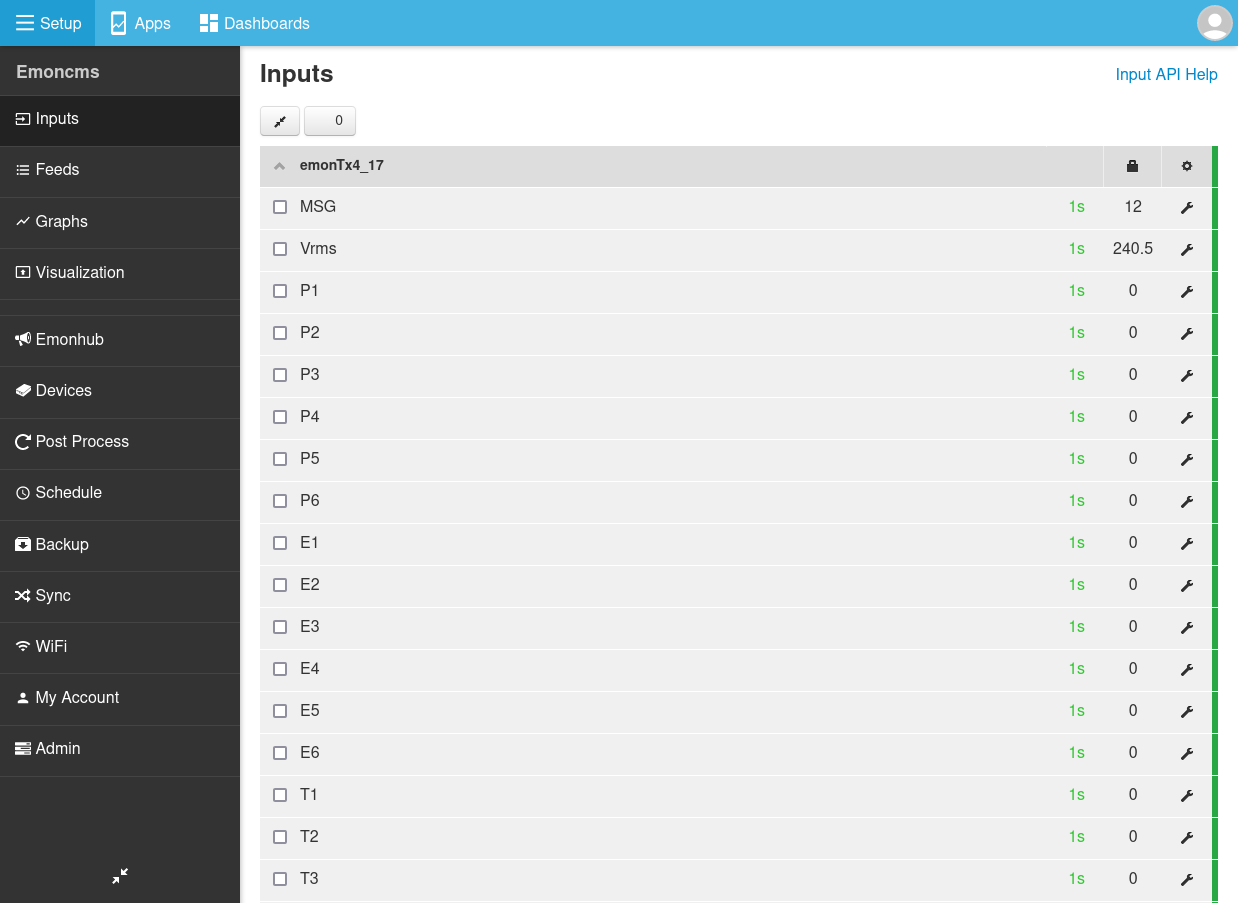
Inputs hold only the most recent value and time associated with incoming data. Each input has an associated “node” identifier and a “key” sub-identifier. To record historic data a feed needs to be created from an input.
Local vs Remote logging
At this point you might want to choose if you want to record and access your data locally on your emonPi/base or post the data to a remote server such as Emoncms.org, or you may want to do both. This will determine where you carry out the next set of configuration steps.
Local vs Remote logging
Both the emonPi and emonBase feature full local data logging and visualisation capability, making it easy to keep your energy data within the privacy of your home and without any online service subscription requirements. The local web interface is accessible via the emonPi/emonBase hostname or IP address.
The emonPi and emonBase SD card includes 10 GB’s of data storage enough for 138 years! worth of feed data for our solar PV application (6 feeds at 10s resolution). The software has also been designed to minimise write wear to prolong SD card lifespan.
If you wish to access your data away from home this is possible using remote access services such as Dataplicity. Dataplicity currently offer a free-tier of one device per user. For more information see: Remote Access.
We do also offer a remote data logging and visualisation service called Emoncms.org. Emoncms.org is a pay-as-you-go service but all OpenEnergyMonitor shop hardware purchases come with 20% free emoncms.org credit which is designed to give 5-10 years of free use.
It is possible to install our emonCMS on your own remote server, we have a nice installation script to help with this for use with Debian systems, see EmonScripts.
Posting data to a remote server such as emoncms.org is particularly useful for applications that require public dashboards as there is usually more bandwidth for many users to access the same dashboard than available over a household or remote monitoring site connection. Remote data logging is also useful for applications that require aggregation or remote data analysis. The OpenEnergyMonitor system provides both local and remote options so that you can choose the right tool for your application.
A quick intro to emonHub
Before we continue with input configuration for local data logging - or - configuring the emonPi/base to post data to a remote server, it’s worth mentioning a piece of software called emonHub.
emonHub is also installed on the emonPi/base and sits just in front of emonCMS, providing a bridge between the hardware side and the emonCMS inputs interface.
emonHub is a seperate piece of software to emonCMS but it can be configured from within the emonCMS interface. It’s also possible to view the emonHub log, which can be valuable when trying to troubleshoot data input issues.
From the Setup menu click on EmonHub to open the emonHub log page
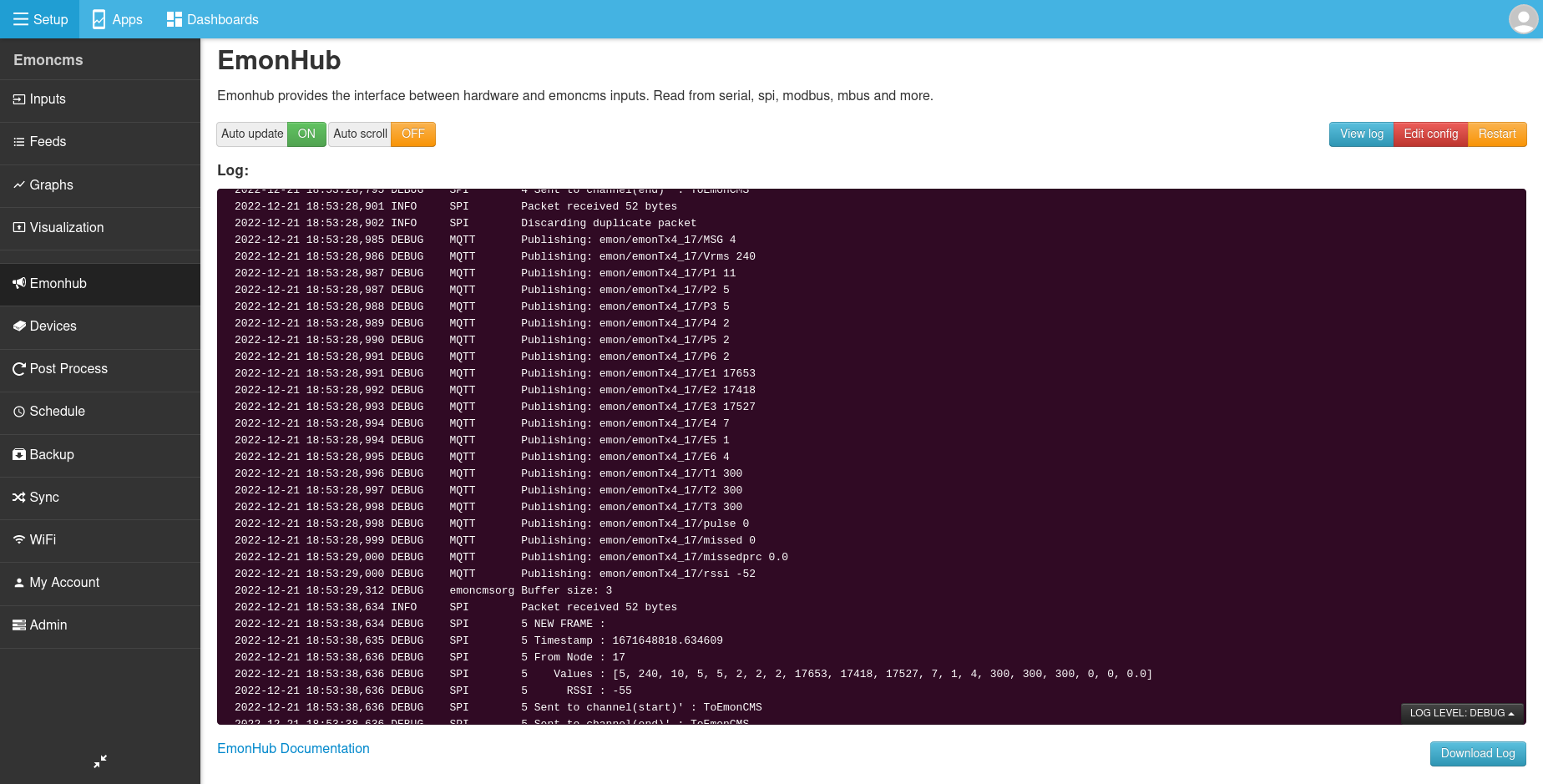
Click on emonHub config to open a basic text editor for the emonHub configuration file
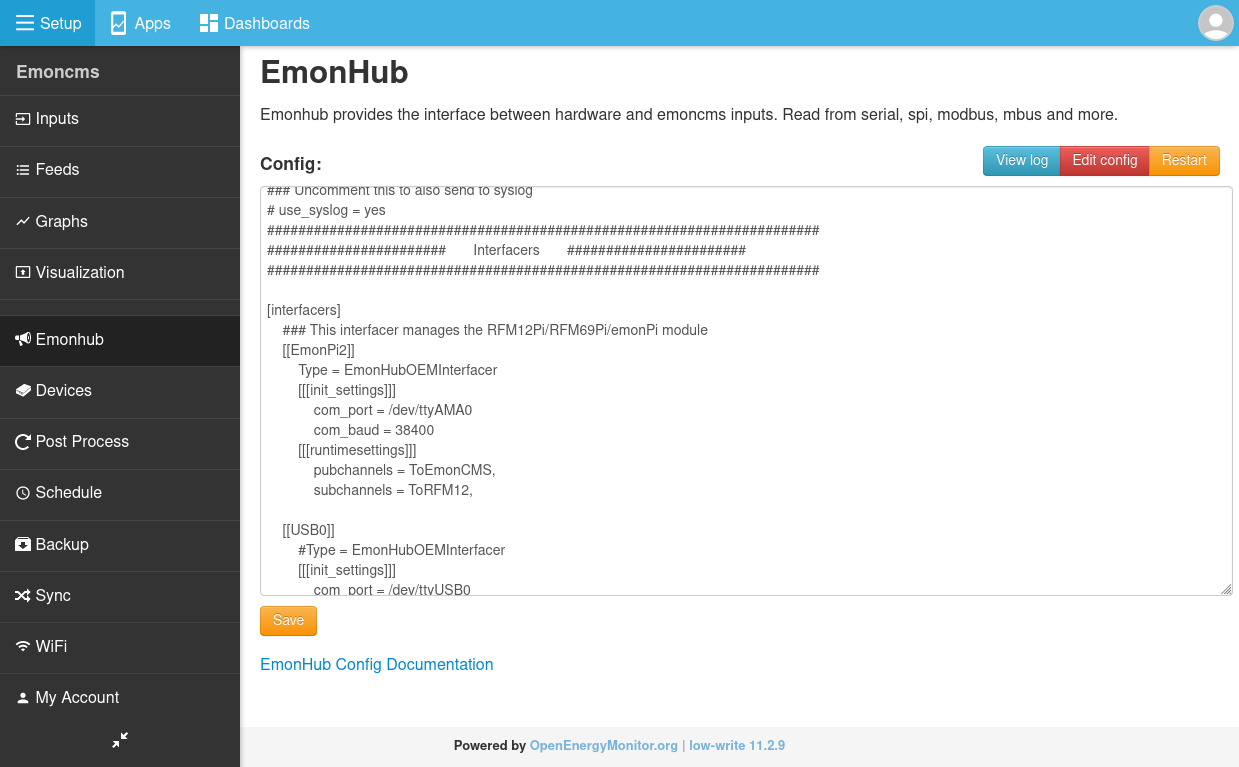
For a more in-depth guide to emonHub configuration, see the emonHub documentation.
The standard configuration is designed to provide out of the box support for the main types of OpenEnergyMonitor hardware, whether that’s receiving data via radio, usb link or hardware mounted directly such as the emonPi. This data is then passed on to emonCMS locally via MQTT and remotely typically via HTTP.
Tip
emonHub also supports reading data from a wide variety of 3rd party sources, extending the functionality of an emonPi/base, including: Modbus (e.g SDM120 electric meters), MBUS (A wide range of heat meters), DS18B20 Temperature sensors, Direct pulse counting, SMA Solar, Victron VE.Direct, Fronius (TCP Modbus), Renogy, Tesla PowerWall. BMW Connected Drive, JLR. See emonHub: Interfacers
Logging data locally
Continuing from where we left off above on the emonPi/base emonCMS inputs page. The following describes a generic example of configuring an emoncms input, e.g an emonTx4 or emonPi power input.
1. Click on the input config spanner next to the input you wish to record:
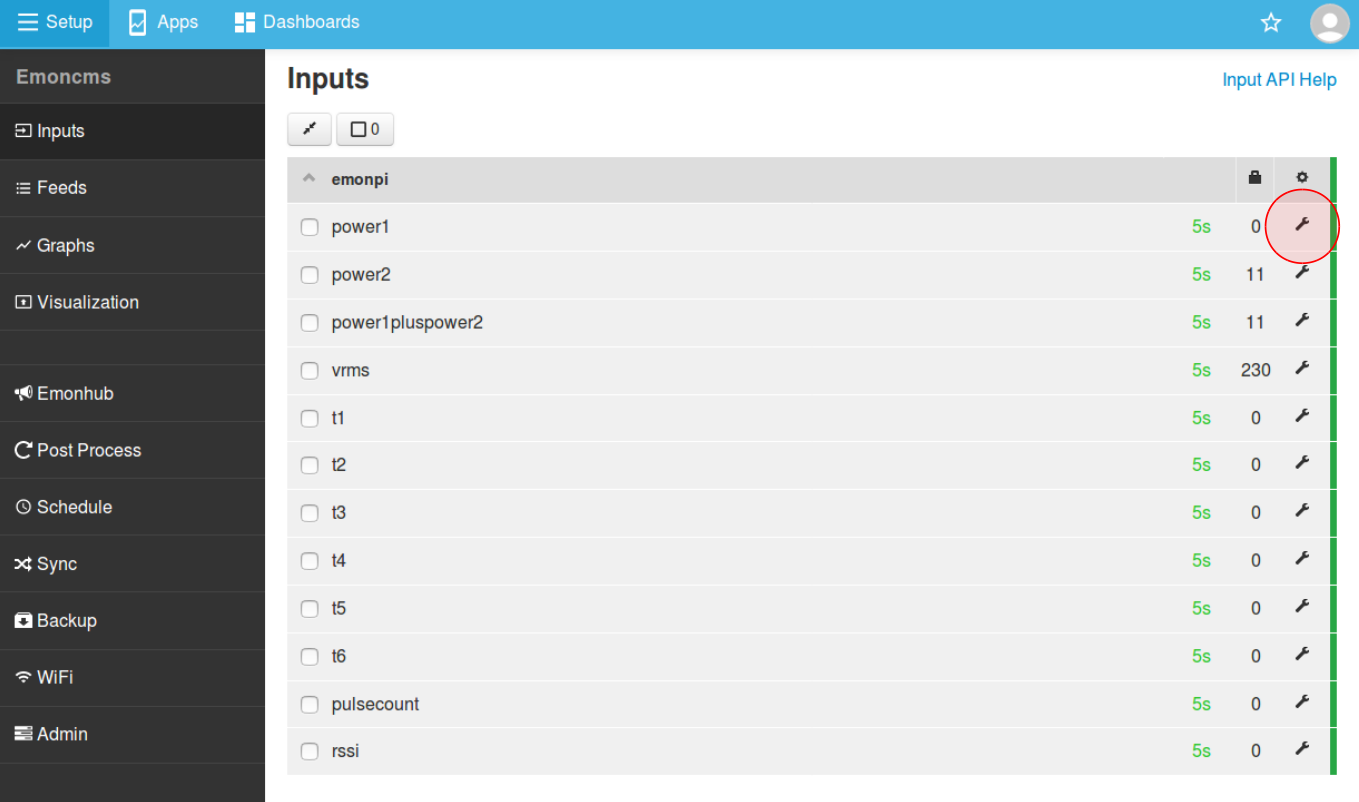
2. The process list setup box will now open.
Choose the
Log to Feedinput process (default).Check that
Feedis set toCREATE NEWand enter a suitable feed name e.guse.Select the default
PHPFINAFeed Engine (default).Select a logging interval e.g.
10sfor emonTx/emonPi or60sfor emonTH**.Click add to
Addto add that input process.
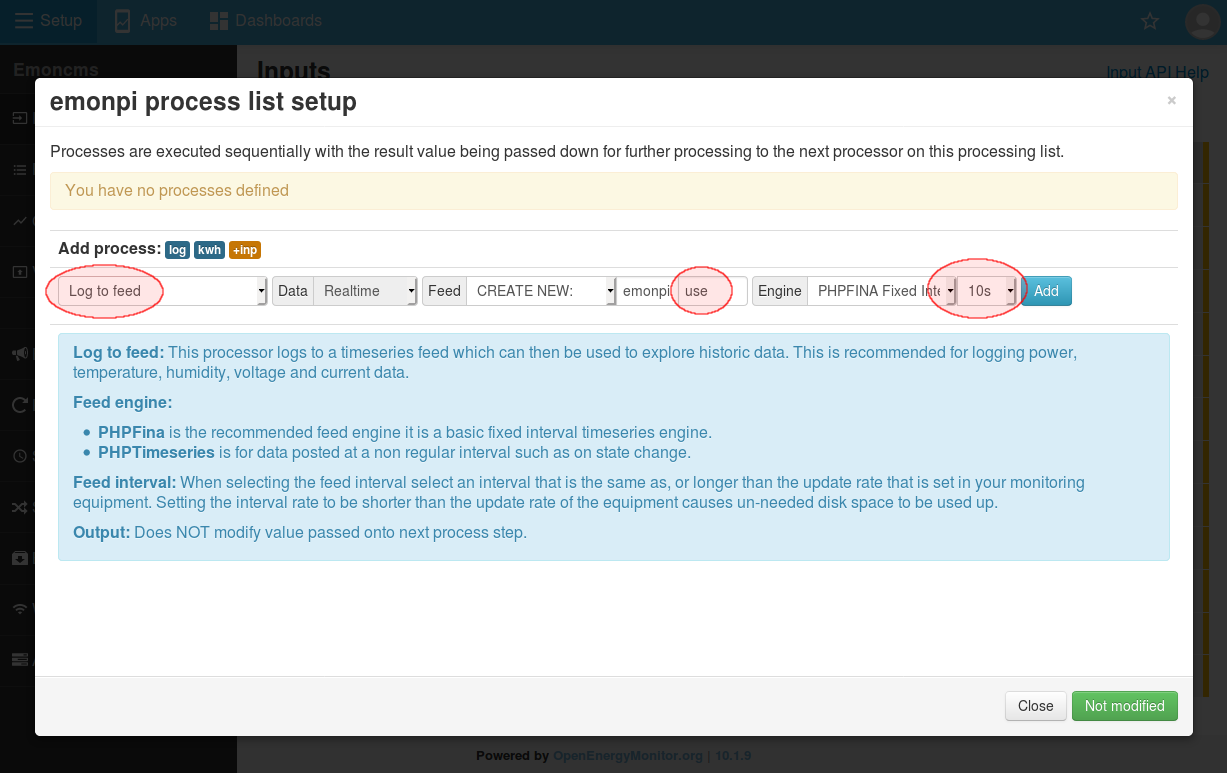
3. If logging a Power value input you may also want to create a corresponding cumulative kWh feed from the power input. This is done by adding a Power to KWh input process.
Note
The emonTx4 and some of our more recent emonTx3 and emonPi firmware’s report cumulative CT channel energy as seperate inputs and these can be used instead of calculating kWh data from power inputs in emonCMS.
Choose
Power to KWhInput Process.Check that
Feedis set toCREATE NEWand enter a suitable feed name e.guse_kwh.Select the default
PHPFINAFeed Engine (default).Select a logging interval e.g.
10sfor emonTx/emonPi.Click add to
Addto add that input process.
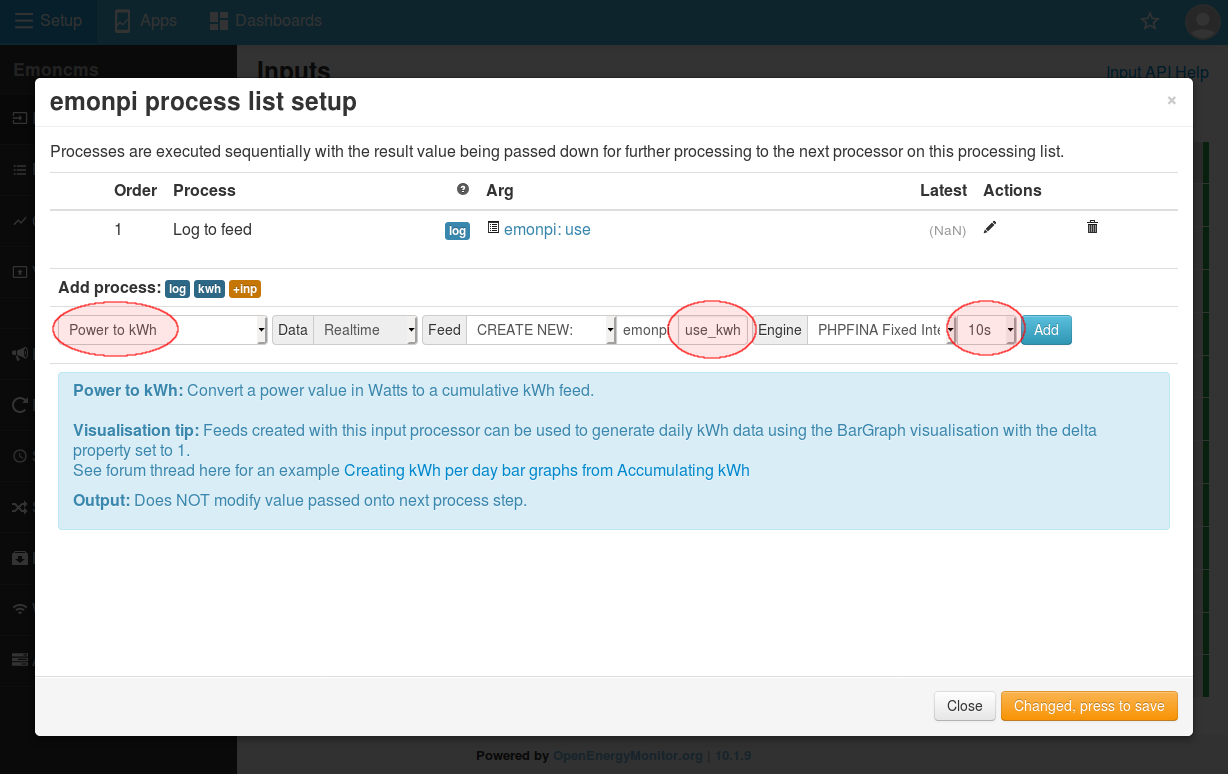
Note
The feed interval logging time should not be less (faster) then the default node update rate. Choosing a longer (slower) update rate is fine and will conserve disk space
Node |
Recommended Interval |
|---|---|
emonPi |
10s |
emonTx3/4 |
10s |
emonTH |
60s |
4. Once complete, click the Changed, Press to Save button. Then Close the input list window.
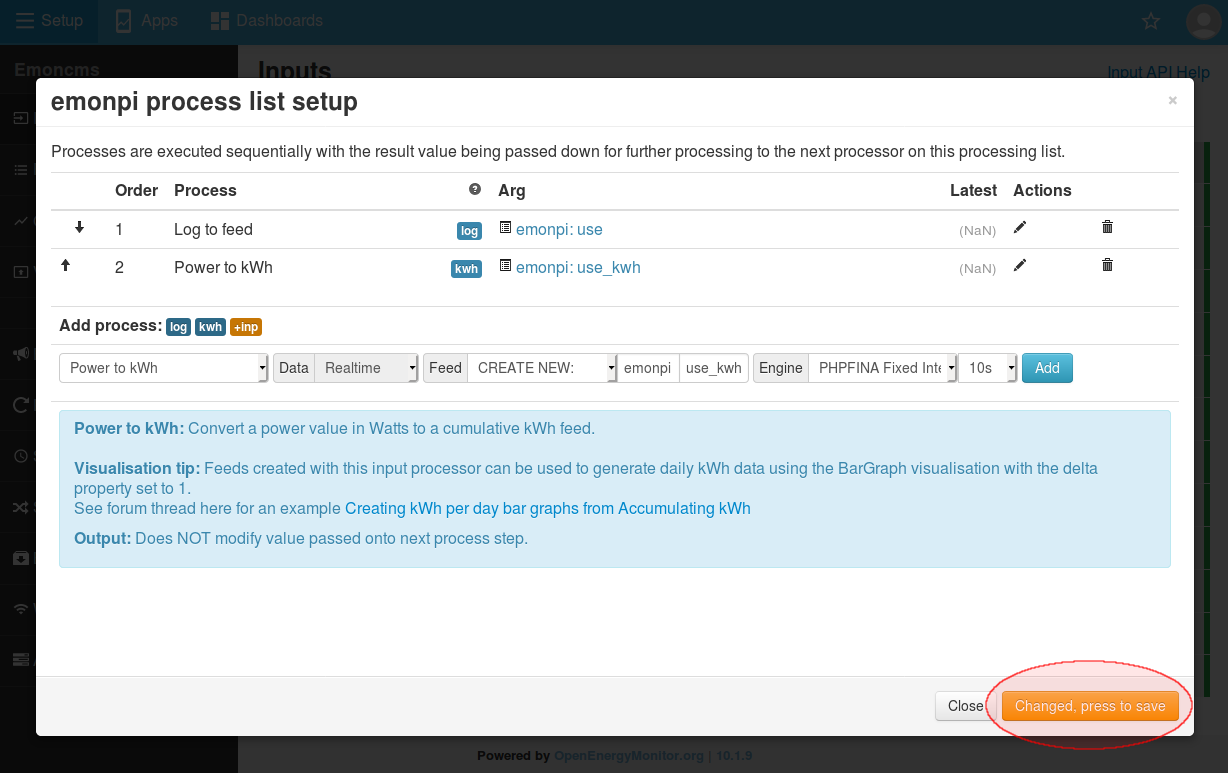
5. The Inputs page should now display the input processes next to the configured input as small short hand labels e.g log and kwh in our example so far:

6. We can now check the feeds that have been created.
Navigate to
Setup > FeedsUpdating feeds should now be visible

7. To view the feed data click on the feed row to open the graph view. As we have only just created the feed there will not be much data to see yet. If you zoom in to the last few minutes you should start to see a couple of datapoints. You may need to click on the Reload button to see these appear - alternatively check back in a few minutes when there are more datapoints.
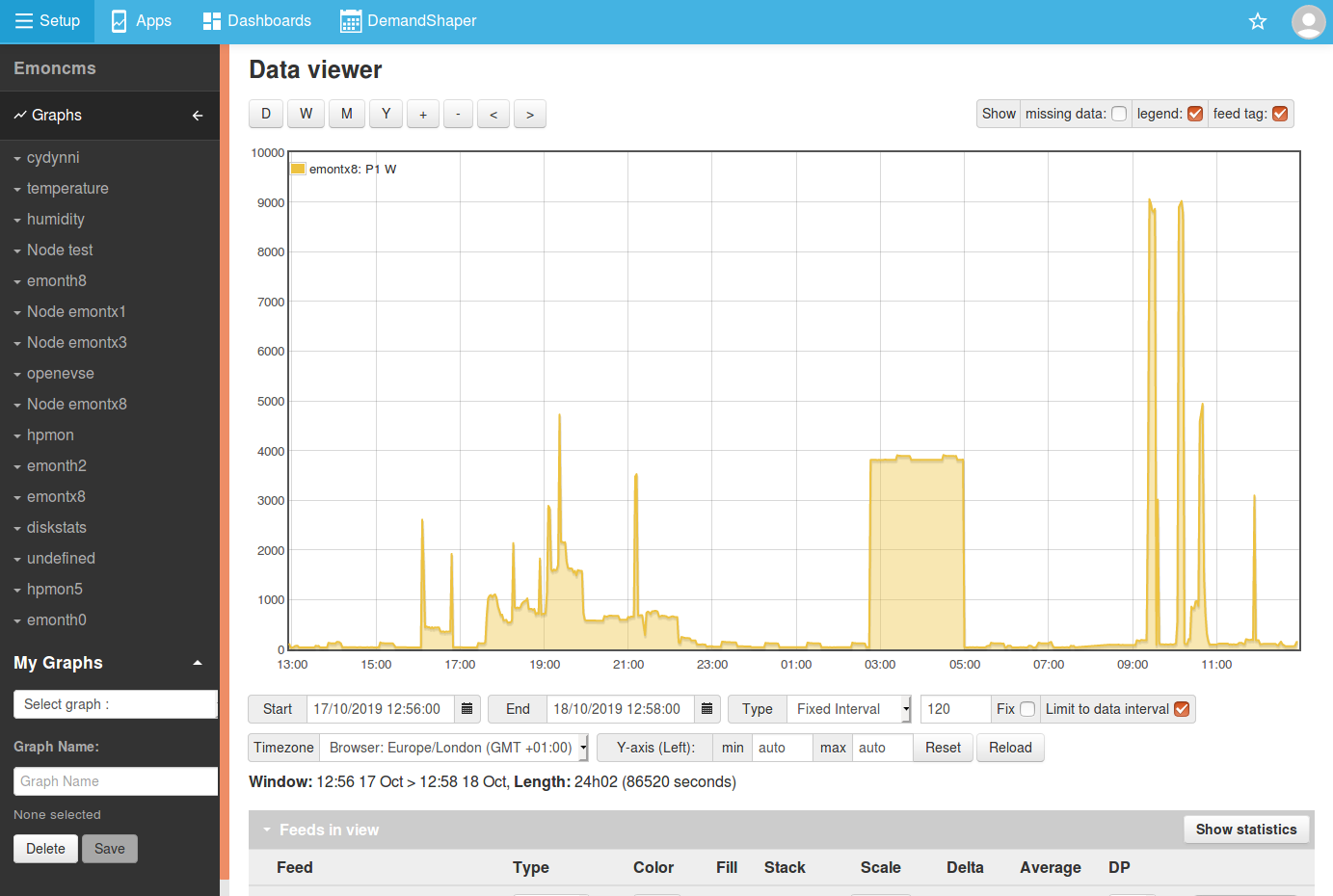
Tip
Multiple feeds can be overlayed on the same graph by selecting feeds in the right hand side
To view daily data see Emoncms > Daily kWh (this requires a couple of days of data).
Posting data to a remote server
The following provides a quick overview of how to configure your emonPi/base to post to emoncms.org. The same mostly applies when posting data to a self hosted emoncms server as well.
1. Open the emoncms.org front page and click register to create a new account. Enter a valid email address (verification required) and a suitable username and password.
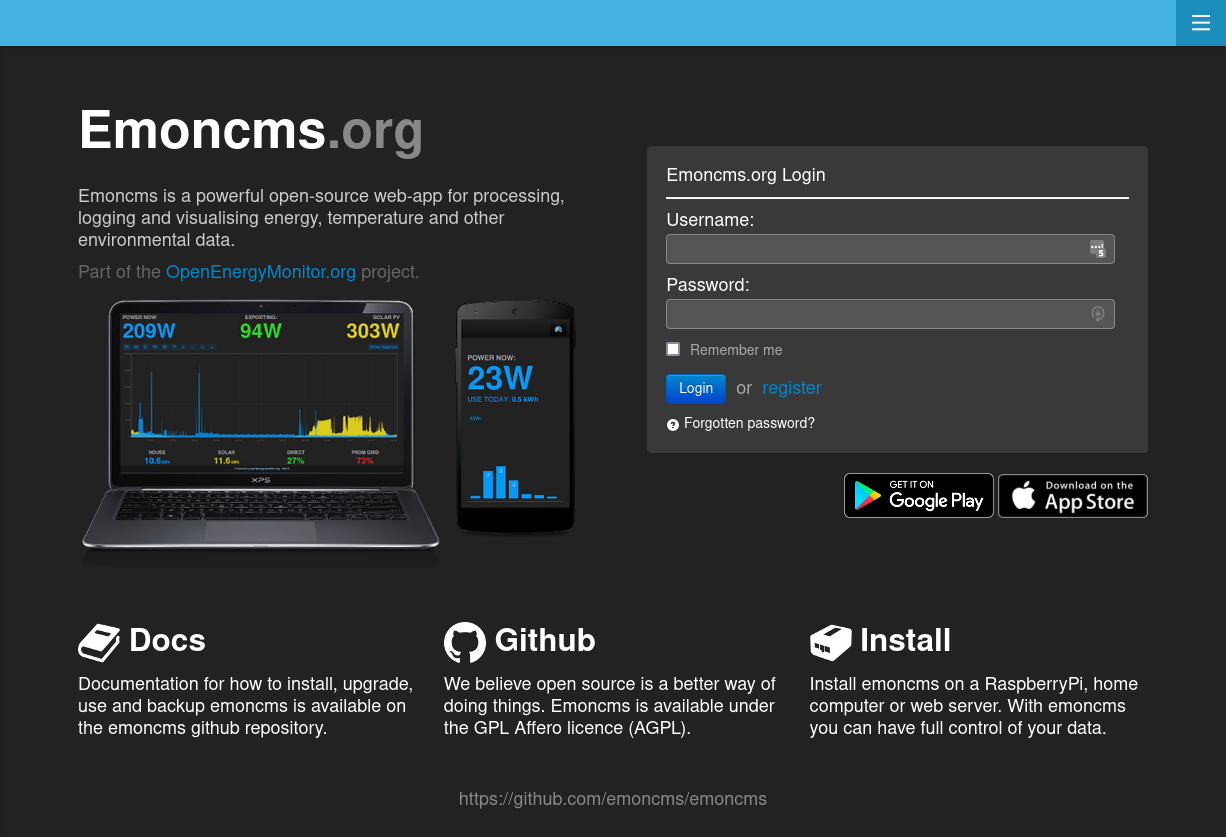
2. Once logged in, navigate to the My Account page, either via the Setup menu or the top-right dropdown. Copy the Read & Write API Key.
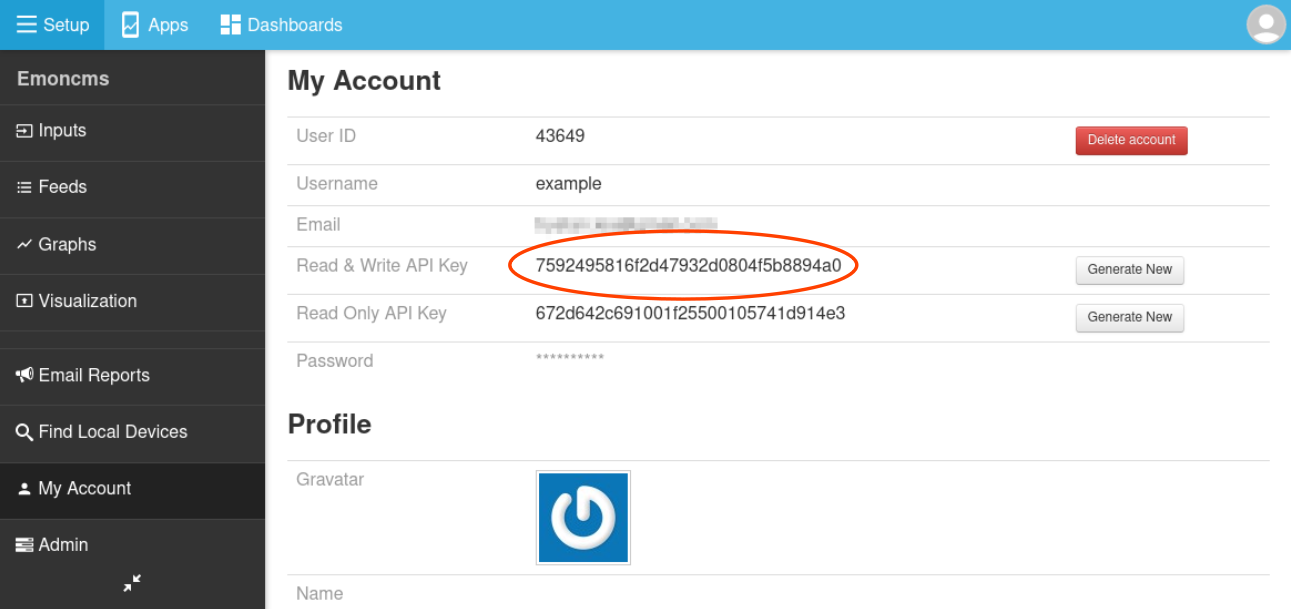
3. Back on your emonPi/Base. Navigate to Setup > EmonHub. Click Edit Config to bring up the emonHub configuration editor. Scroll down to find the [[emoncmsorg]] interfacer and replace the apikey = xxxxxxxxxxxxxxxxxxxxxxxxxxxxxxxx with the read & write api key copied in step 2.
Click Save to complete.
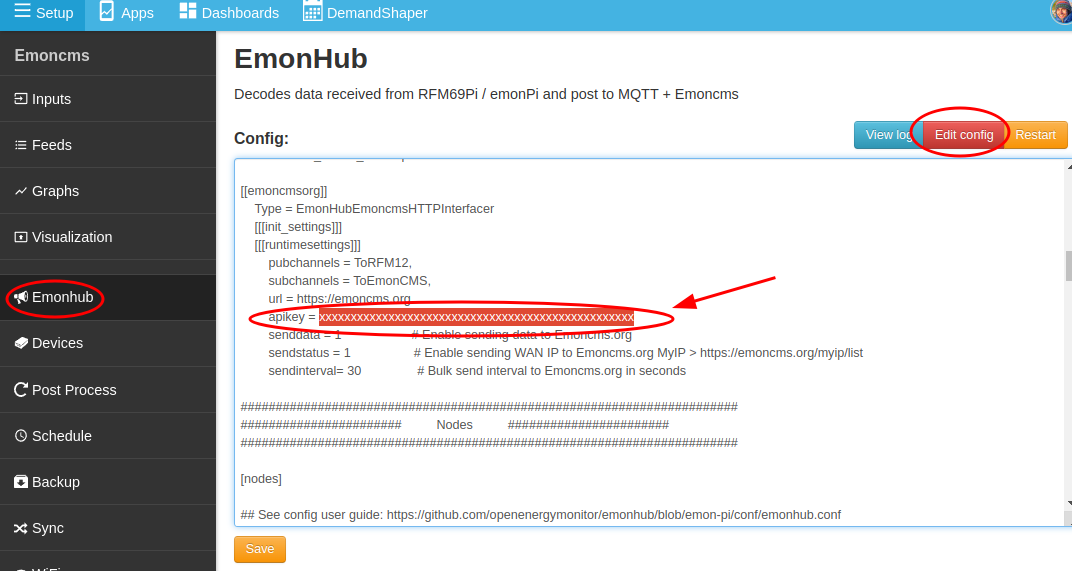
4. If you can see input data on your local emonPi/Base inputs page you should now start to see the same inputs come through on emoncms.org. These can be configured in the same way as covered in the ‘Logging data locally’ section.